PhD student
Contact :
Unité d’Ecologie Sociale (USE)
ULB CP 231
Campus de la Plaine
bd du Triomphe, B-1050 Bruxelles
E-mail: Pauline.Gardin@ulb.be
Tel: 02.650.55.30 (from abroad +32.2.650.55.30)
Fax: 02.650.59.87 (from abroad +32.2.650.59.87)
Research
Mutualism or antagonism in tripartite relationships between ants, aphids and parasitoid wasps: understanding of coexistence mechanisms of concerned species
In ecosystems, many species coexist and exploit the same resources. This is the case of the tripartite system involving aphids, ants and parasitoids. Aphids are an abundant source of protein for the insects consuming them and their honeydew a source of sugar. Thus, ants have developed a mutualistic relationship with aphids by exploiting their honeydew and maintaining the colonies. Meanwhile, aphid parasitoids exploit protein resources at the larval stage (parasitic predation) as well as the honeydew at the adult stage (commensalism). Although they exploit the same resource, ants and parasitoids coexist in environments where aphids are present.

In apple orchards, the rosy apple aphid (Dysaphis plantaginea) is attended by the ant Lasius niger. This ant species is aggressive towards the presence of parasitoids wasp in protected colonies. Yet, the parasitoids Binodoxys angelicae and Ephedrus persicae are regularly found in these colonies. The main goal of this project is to understand the mechanisms allowing each of these species to coexist. We hypothesize that parasitoids are able to adapt their behavior in the presence of ants and thus stay in the orchards. The fitness gain brought by ants to aphids would then compensate the impact of parasitoids on them.

This project is divided in three sections :
1) the analysis of the impact of L. niger on the fitness of D. plantaginea on apple trees ;
2) the analysis of the parasitism capacity of E. persicae and B. angelicae on D. plantaginea in the presence or absence of L. niger ;
3) the analysis of the behavior of L. niger with respect to parasitized aphids of D. plantaginea.
A better knowledge of this tripartite relationship will highlight the mechanisms explaining the coexistence of these species in ecosystems.
